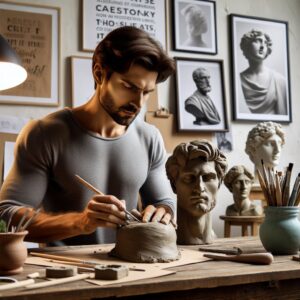Table Of Contents
- 1 Unmolding Creativity: Introduction to Learning Clay Sculpting
- 1.1 Building the Foundation: Understanding How to Learn Clay Sculpting
- 1.2 1. Self-guided learning:
- 1.3 2. Formal education:
- 1.4 3. Online learning platforms:
- 1.5 4. Apprenticeship and mentorship:
- 1.6 5. Joining a community:
- 1.7 Molding Your Skills: Essential Tools, Techniques, and Resources
- 1.8 Essential Tools:
- 1.9 Fundamental Techniques:
- 1.10 Valuable Resources:
- 1.11 Shaping Your Creative Future: Conclusion and FAQs
- 1.12 Key Takeaways:
- 1.13 Frequently Asked Questions:
- 1.13.1 1. What is the best type of clay for beginners?
- 1.13.2 2. How long does it take to learn clay sculpting?
- 1.13.3 3. Are there any online resources that offer free clay sculpting lessons?
- 1.13.4 4. What are some tips for overcoming creative challenges while sculpting?
- 1.13.5 5. How can I find a community of clay sculptors?
Unmolding Creativity: Introduction to Learning Clay Sculpting

Have you ever held a lump of clay in your hands and felt a spark of creative potential ignite within you? Clay sculpting, an ancient art form, offers a unique and accessible way to express your imagination, develop valuable skills, and experience the joy of shaping something tangible from scratch. While the process may seem intimidating to beginners, with the right guidance and resources, anyone can embark on a fulfilling journey into the world of clay sculpting.
In this blog series, we’ll demystify the learning process and provide you with comprehensive information and practical tips to get started. Whether you’re a curious beginner or an aspiring artist seeking to hone your skills, this guide will equip you with the knowledge and confidence to explore the expressive possibilities of clay sculpting.
We’ll begin by exploring the various types of clay available, each possessing its own unique properties and ideal for different sculpting styles. From the versatile polymer clay to the natural beauty of air-dry clay, we’ll delve into their characteristics and provide recommendations to help you choose the right clay for your project.
Additionally, we’ll introduce essential tools and techniques that form the foundation of clay sculpting. We’ll explore basic shaping techniques like pinching, rolling, and scoring, along with methods for joining clay pieces and adding texture and detail. By mastering these fundamental skills, you’ll be able to translate your creative ideas into tangible clay creations.
In the next session, we’ll delve deeper into the meaning of “learning clay sculpting” and explore the various avenues available for acquiring the necessary skills and knowledge.
Building the Foundation: Understanding How to Learn Clay Sculpting

Learning clay sculpting is a journey of self-discovery, a process of exploring your creative potential and developing new skills. It’s more than just understanding how to manipulate clay; it’s about embracing the transformative power of this art form to shape your artistic expression.
Multiple avenues exist for acquiring the knowledge and skills necessary to become a skilled clay sculptor:
1. Self-guided learning:
- Books and online resources: Numerous books, websites, and online tutorials offer comprehensive lessons, step-by-step guides, and valuable information on different clay sculpting techniques.
- Practice and experimentation: The beauty of clay sculpting lies in its forgiving nature. Don’t be afraid to experiment with different techniques, tools, and clays to discover what works best for you.
2. Formal education:
- Art classes and workshops: Local art centers, community colleges, and private studios often offer beginner-friendly clay sculpting classes and workshops. These provide a structured learning environment with expert guidance and personalized feedback.
- Art schools and universities: For those seeking a deeper immersion into the art form, art schools and universities offer degree programs in sculpture, ceramics, and other related fields.
3. Online learning platforms:
- Online courses and tutorials: Several online platforms offer comprehensive clay sculpting courses with video lessons, downloadable resources, and interactive features. These provide flexibility and accessibility for those who prefer a remote learning experience.
4. Apprenticeship and mentorship:
- Working with a sculptor: Learning directly from a seasoned artist through an apprenticeship or mentorship program allows you to gain invaluable hands-on experience and personalized guidance.
5. Joining a community:
- Connecting with other clay artists: Join online forums, groups, and communities dedicated to clay sculpting. This provides a platform to share your work, receive feedback, and learn from others on their creative journeys.
No matter which path you choose, remember that learning clay sculpting is a continuous process. Embrace the challenges, celebrate your successes, and most importantly, enjoy the creative journey.
In the next, we’ll delve deeper into the practical aspects of learning clay sculpting, exploring essential tools, techniques, and resources to help you get started.
Molding Your Skills: Essential Tools, Techniques, and Resources

With a foundation in the different ways to learn clay sculpting, now comes the exciting part – getting your hands dirty and starting to create! To help you embark on your artistic journey, let’s explore essential tools, techniques, and resources that will empower you to transform your creative vision into reality.
Essential Tools:
- Sculpting tools: A basic set of sculpting tools such as sculpting knives, spatulas, and loop tools will allow you to manipulate and shape the clay with precision.
- Rolling pins and mats: These tools help you roll out clay evenly and in various thicknesses, ideal for creating flat forms and intricate details.
- Texture tools: Experiment with textured rollers, stamps, and other tools to add depth and visual interest to your clay creations.
- Brushes: Soft brushes are helpful for smoothing surfaces, blending edges, and applying slip (a liquid clay mixture used for joining pieces).
- Glazes and paints: Once your pieces are dry, consider adding color and depth with glazes and paints.
Fundamental Techniques:
- Pinch method: This basic technique involves pinching and manipulating the clay to create simple forms like spheres, cones, and cylinders.
- Coil method: Build intricate shapes and structures by rolling clay into coils and joining them together.
- Slab construction: Roll out clay slabs to create flat pieces that can be cut, shaped, and assembled to form various objects.
- Scoring and slipping: These techniques are essential for joining clay pieces securely. Scoring creates rough surfaces that allow the slip to form a strong bond.
- Adding texture: Experiment with different tools and techniques to add texture to your sculptures, enhancing the visual interest and storytelling potential of your artwork.
Valuable Resources:
- Books: Numerous books offer comprehensive guides and detailed instructions on various clay sculpting techniques. Some popular options include “The Complete Book of Polymer Clay” by Lisa Pavelka and “The New Ceramics” by Paul Scott.
- Online tutorials: Websites like YouTube and Skillshare offer a wealth of free and paid tutorials covering specific techniques, projects, and tips for beginners.
- Art supply stores: Local art supply stores often host workshops and classes, provide expert advice on choosing tools and materials, and offer a supportive environment for learning and exploring.
- Online communities: Join online forums and communities dedicated to clay sculpting to connect with fellow artists, share your work, receive feedback, and find inspiration.
By starting with these fundamental tools, techniques, and resources, you’ll be well-equipped to embark on your clay sculpting journey. Remember, practice makes perfect. The more you experiment and create, the more confident you’ll become in your skills and abilities.
Now in next, we’ll summarize key takeaways and address frequently asked questions, providing you with the confidence and knowledge to embark on your creative journey with clay.
Shaping Your Creative Future: Conclusion and FAQs
As we conclude our exploration of learning clay sculpting, let’s solidify your understanding with key takeaways and address frequently asked questions to empower you to confidently embark on your artistic journey.
Key Takeaways:
- Clay sculpting offers a rewarding and accessible way to express your creativity, develop valuable skills, and experience the joy of creating tangible art.
- Multiple avenues exist for learning clay sculpting, including self-guided learning, formal education, online platforms, apprenticeships, and joining a community.
- Essential tools for clay sculpting include sculpting knives, spatulas, loop tools, rolling pins and mats, texture tools, brushes, and glazes/paints.
- Fundamental techniques to master include the pinch method, coil method, slab construction, scoring and slipping, and adding texture.
- Numerous resources are available to support your learning journey, including books, online tutorials, art supply stores, and online communities.
Frequently Asked Questions:
1. What is the best type of clay for beginners?
Air-dry clay is a good option for beginners as it’s easy to use, dries at room temperature, and doesn’t require firing. Polymer clay offers more versatility but requires baking in an oven.
2. How long does it take to learn clay sculpting?
The time it takes to learn clay sculpting varies depending on your individual learning pace, dedication, and desired skill level. However, with consistent practice and exploration, you can achieve significant progress in a relatively short time.
3. Are there any online resources that offer free clay sculpting lessons?
Many websites and YouTube channels offer free tutorials and lessons on various clay sculpting techniques and projects. Some popular resources include The Polymer Clay Club and Creativebug.
4. What are some tips for overcoming creative challenges while sculpting?
Don’t be afraid to experiment, make mistakes, and learn from them. Be patient and persevere, even when facing difficulties. Seek inspiration from other artists, explore different techniques, and most importantly, have fun!
5. How can I find a community of clay sculptors?
Many online forums and social media groups are dedicated to clay sculpting. Local art centers and community colleges often host workshops and classes, providing opportunities to connect with other artists.
By embracing the transformative power of clay sculpting, you embark on a journey of self-discovery, artistic expression, and creative fulfillment. Remember, the most important thing is to start, experiment, and enjoy the process. So, grab some clay, get your hands dirty, and start shaping your creative vision into reality!
1 thought on “Step To Step Guide How To Learn Clay Sculpting”